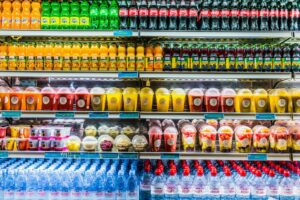Read an article by Professor Edward Kosior of Nextek on its new project, NEXTLOOPP.
NEXTLOOPP, the groundbreaking project by Nextek Limited, to close the loop on food-grade Polypropylene has been breaking new boundaries of late with the revelation of its highly successful tracer-based sorting trials held at TOMRA (Germany) in September 2021.
The trials, to specifically sort food-grade plastic packaging waste, were based on the actual packs that the members of the NEXTLOOPP project submitted for sorting. They focused on establishing the selectivity of sorting these packs when co-mingled with 20% non-food packs, and the results were a resounding 99.3% sorting purity in a single pass at maximum production speed. A double pass improves purity to greater than 99.9%.
This is particularly impressive as it demonstrates for the first time how the integrated technologies of pack, label with marker (and NIR/VIS automatic sorter) could work together at full speed in a real world context.
It also demonstrates Nextek’s unique technology can efficiently differentiate food packaging from non-food packaging to meet the standards required by the Food Standards Authorities in the UK and EU.
Being able to identify and sort any number of pack variants from detergent packs to soup and yoghurt packages in any plastic type is a world-first that will transform the way we recycle the prolific volume of single-use post-consumer food packaging waste back into circular applications. As such these trials herald a new era in the plastics packaging recycling industry and the validation of Nextek’s PolyPRISMTM marker system as ‘plug-and-play’ ready on TOMRA’s sorting equipment for commercial use.
This is timely given the urgent need to slash the world’s greenhouse emissions. Like it or not plastics will be an important part of the future – how we manage them could potentially dictate how we solve some of our core environmental issues.
According to the World Bank material recovery from both recycling and waste streams could result in potential savings of 2.76 billion tons of CO2 emissions.
For this to occur, however, we need to improve our sorting and recycling technologies for packaging to deliver greater circularity and recycled content.
We also must shift our global mindset to design for recycling not to mention face the uncomfortable truth that we have to drastically reduce the growth in plastics production.
For some this may sound like a hurdle too far, yet recyclables are the most impactful way to reduce our CO2 emissions as they reduce our reliance on the use and discard model that drives exporting, burning and landfilling of plastics and sets us on the more sustainable path of re-using, recycling and closing loops.
As it stands at least 25 per cent of packaging put on the market around the world has not been designed for recycling. If we address the complex issue of food-grade packaging there is still little to no recycling built in this prolific polymer category.
Yet PP is the biggest plastics fraction in the FMCG sector. In the UK alone, 210,000 tonnes of food-grade PP packaging is used in pots, tubs, trays and films each year (WRAP 2018). An equivalent volume of recycled resin, containing 30% recyclate, would save 63,000 tonnes of virgin plastics being produced and the equivalent volume of PP food waste packaging being reused to its highest purpose, rather than going to waste-to-energy, landfill or into lesser polymers.
And this brings us to the tricky topic of recycled content ratios, because not all recycled plastic is equal.
We need to refer to the intrinsic CO2e footprint of the base plastics to ensure our choices have the smallest CO2 footprint. Recycled HDPE and recycled PP have a 25 per cent lower carbon footprint than recycled PET, and when comparing recycled content, a 30 per cent recycled PP or high density plastic has the same carbon footprint as 73 per cent recycled PET.
So whilst PET has been a true recycling success story, from a CO2 perspective we should be looking to recycle more HDPE and PP than PET.
This makes it imperative that we commercialise technologies to mechanically recycle LLDPE, HDPE and PP back into food-grade resins and products to create greater circularity and CO2e savings.
One of the challenges to achieving this is sorting, which is key to enhancing recycled plastics.
We are seeing a big focus and a lot of talk around a range of new technologies to facilitate sorting, from digital markers to spectroscopic and digital sorting. Rather than vying for popularity the world would benefit from a combination of these technologies to tackle the multi-faceted sorting issues not to mention the retailer interfaces brand owners want.
We need to be driving rapid already-deliverable improvements in packaging waste through mechanical recycling meshed with cutting edge sorting and decontamination technologies. As such fluorescent markers that only require the addition of one layer of ink on the label to enable it to become fluorescent would already greatly boost the recycling of materials into food and non food applications.
Furthermore a simple enhancement of the existing equipment in MRFs will detect these fluorescent labels as the recent TOMRA trials demonstrated.
Sorting plastic waste into polymer types is the first of three vital steps needed to close the loop on PP and create a global low carbon economy. The next step requires splitting the plastic packaging into food and non-food fractions. The final step involves NEXTLOOPP’s patented decontamination process, PPristineTM, which unlocks the markets to food packaging.
NEXTLOOPP is confident it can demonstrate that the packaging resins will be free from contaminants and that they will meet all the migration requirements of EFSA and USFDA.
If we are to make better use of our plastic packaging waste we need to turn it back into high quality recycled mono-polymers that can be re-used in new products. Only then will plastic truly come into its own as the valuable, low carbon material it has the potential of becoming.




